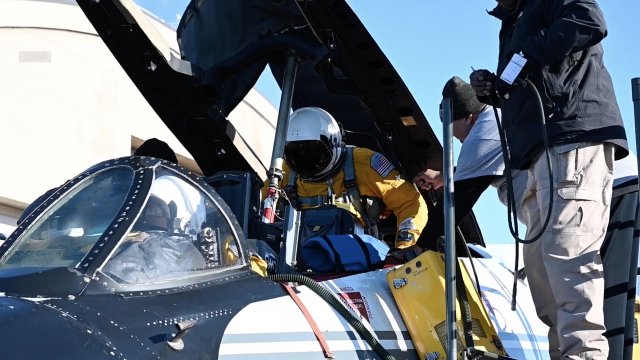It's a research mission unlike any other into the upper layer of our atmosphere.
"Most parts of the atmosphere matter to us in one way or another," said Troy Thornberry, a research physicist with The National Oceanic and Atmospheric Administration (NOAA).
That's the case with NOAA's SABRE mission, which focuses on our stratosphere.
"The stratosphere is an important region of our atmosphere because that's where the ozone layer exists," Thornberry said. "The ozone layer is what shields us from a lot of the ultraviolet rays from the sun."
Using a converted Cold War-era bomber, NOAA's chemical sciences laboratory is working to decode the makeup of our stratosphere.
"There might be questions as to, well, the stratosphere: It's remote. There's not much air there," Thornberry said. "Why do we care about it one way or another? And the answer to that really is because it does play a significant role in climate."
The plane, which just completed a series of flights above the arctic in Alaska, is equipped with 17 sampling instruments, making it basically an airborne laboratory.
With pilots in pressurized suits, the plane soars across the stratosphere, miles above the ground. During hours-long flights, the sampling instruments collect extensive data on trace gases and aerosols, providing insight into the state of the stratosphere and the processes occurring there.
"Going to the high altitude and making measurements allows us to see sort of the end point of these stratospheric processes," Thornberry said. "In this case, we went up, and we made measurements of various trace gas species that tell us how old, how long that air has been in the stratosphere, as well as all of the aerosol components to understand micro physics and composition."
SEE MORE: Planet with scorching hot atmosphere is crucial for finding new Earth
Now back at their lab in Boulder, Colorado, the team behind SABRE are analyzing the data collected from the flights in Alaska. The goal is to use the information collected from those flights and others to help inform policy decisions regarding emissions and potential climate intervention measures.
"We take all of our understanding, we put them into the global models ... and we can then take that model and run it forward and say we understand how the atmosphere is going to evolve. We understand how the climate is going to change when these various things happen," Thornberry said.
Many of the measurement tools used onboard the plane are actually built from scratch on site and patented. That's because there isn't exactly a store that has the instruments NOAA needs to answer the questions its team is asking.
"One of the pieces of the challenge is that they've got to be on a plane, right? And so, if you want to put these things on a plane, they have to be relatively light, and they have to be relatively small in terms of their footprint," said Gregory Schill, a research chemist with NOAA Chemical Sciences Laboratory. "The PALMS instrument measures particulate matter composition, so smoke from fires or dust from dust storms, sea spray from oceans. We can see if those particles are coming from above or they are raining down from outer space or are they coming from special sources, like spacecraft debris or pieces of rockets that are being ablated in the upper atmosphere?"
As the team gets to work preparing the instruments for the next series of flights in 2024, they say there's a lot more to learn about the atmosphere right above our heads.
"The data that we get really is kind of a gold mine, but it's also a snippet, right?" Schill said. "We're really trying to use this data and leverage it in the best possible way because of that."
Trending stories at Scrippsnews.com



